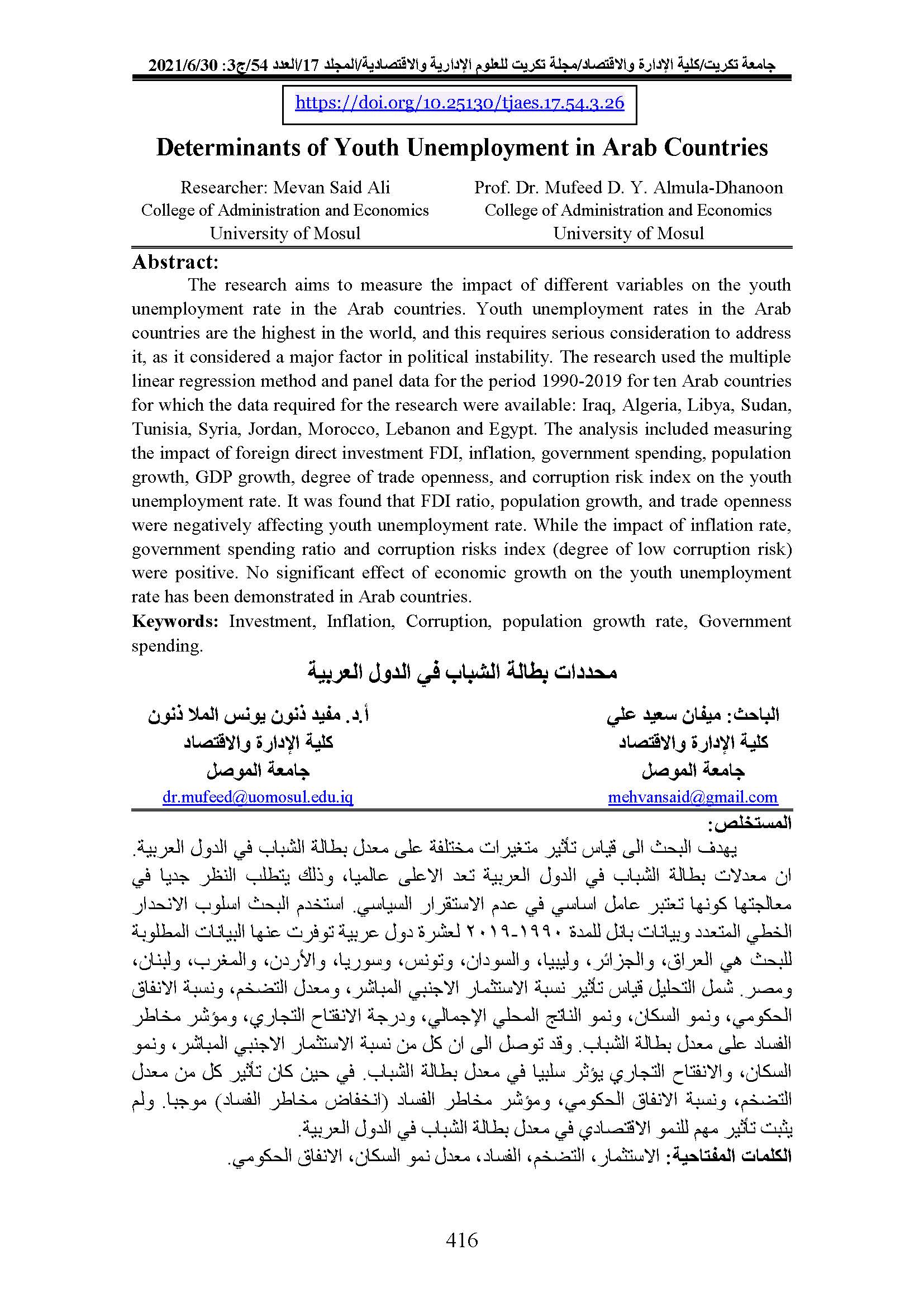محددات بطالة الشباب في الدول العربية
محتوى المقالة الرئيسي
الملخص
يهدف البحث الى قياس تأثير متغيرات مختلفة على معدل بطالة الشباب في الدول العربية. ان معدلات بطالة الشباب في الدول العربية تعد الاعلى عالميا، وذلك يتطلب النظر جديا في معالجتها كونها تعتبر عامل اساسي في عدم الاستقرار السياسي. استخدم البحث اسلوب الانحدار الخطي المتعدد وبيانات بانل للمدة ١٩٩٠-٢٠١٩ لعشرة دول عربية توفرت عنها البيانات المطلوبة للبحث هي العراق، والجزائر، وليبيا، والسودان، وتونس، وسوريا، والأردن، والمغرب، ولبنان، ومصر. شمل التحليل قياس تأثير نسبة الاستثمار الاجنبي المباشر، ومعدل التضخم، ونسبة الانفاق الحكومي، ونمو السكان، ونمو الناتج المحلي الإجمالي، ودرجة الانفتاح التجاري، ومؤشر مخاطر الفساد على معدل بطالة الشباب. وقد توصل الى ان كل من نسبة الاستثمار الاجنبي المباشر، ونمو السكان، والانفتاح التجاري يؤثر سلبيا في معدل بطالة الشباب. في حين كان تأثير كل من معدل التضخم، ونسبة الانفاق الحكومي، ومؤشر مخاطر الفساد (انخفاض مخاطر الفساد) موجبا. ولم يثبت تأثير مهم للنمو الاقتصادي في معدل بطالة الشباب في الدول العربية.
التنزيلات
تفاصيل المقالة
المراجع
Alawin M., (2013), Trade Balance and Unemployment in Jordan, European Scientific Journal, vol.9, No.7, pp. 143-151:
https://citeseerx.ist.psu.edu/viewdoc/download?doi=10.1.1.975.5820&rep=rep1&type=pdf
Arslan M., and R. Zaman, (2014), Unemployment and Its Determinants: A Study of Pakistan Economy (1999-2010), Journal of Economics and Sustainable Development, Vol.5, No.13, pp. 20-24. https://core.ac.uk/download/pdf/234646459.pdf
Aurangzeb D., and K. Asif, (2013), Factors Effecting Unemployment: A Cross Country Analysis, International Journal of Academic Research in Business and Social Sciences, Vol. 3, No. 1, pp. 219-230. http://hrmars.com/admin/pics/1448.pdf
Behar A. and J. Mok, (2015), “Does Public Employment Reduce Unemployment?”, Topics in Middle Eastern and African Economies, Vol. 17, Issue 2, pp 110-121.
Bouzid B., (2016), Dynamic Relationship between Corruption and Youth Unemployment: Empirical Evidences from a System GMM Approach. Policy Research Working Paper; No. 7842. World Bank, Washington, DC, pp 1-23:
https://openknowledge.worldbank.org/handle/10986/25158
Chella, N. and Phiri, A. (2017), ‘Long-run cointegration between foreign direct investment, direct investment and unemployment in South Africa’, Munich Personal RePEc Archive, MPRA:
https://mpra.ub.uni-muenchen. de/82371/1/MPRA_paper_82371.pdf.
Chu T., et al, (2020), “The impact of productive and non-productive government expenditure on economic growth: an empirical analysis in high-income versus low- to middle-income economies”, Empirical Economics, 58, pp 2403-2430. https://link.springer.com/article/10.1007/s00181-018-1616-3
Dhamija N., (2019), Trade Liberalization and Unemployment in India: A State Level Analysis, MPRA, pp. 1-27. https://mpra.ub.uni-muenchen.de/95001/
Dutt P., et al, (2007), International Trade and Unemployment: Theory and Cross-National Evidence, pp. 1-32:
https://www.economics.uci.edu/files/docs/workingpapers/2007-08/ranjan-08.pdf
Eita J. and J. Ashipala, (2010), Determinants of Unemployment in Namibia, International Journal of Business and Management Vol. 5, No. 10, pp. 92-104:
https://www.researchgate.net/publication/46302799_Determinants_of_Unemployment_in_Namibia
Feldmann H., (2009), “Government Size and Unemployment: Evidence from Developing Countries”, The Journal of Developing Areas, Vol. 43, No. 1, pp. 315- 330.
Gaber H., (2018), Determinants of Unemployment: Empirical Evidence from Palestine, MPRA, pp.1-11. https://mpra.ub.uni-muenchen.de/89424/6/MPRA_paper_89424.pdf
Grahovac D. and Softić, S., (2017), ‘Impact of the FDI on Unemployment rate in countries of West Balkan’, Review of Innovation and Competitiveness: A Journal of Economic and Social Research, 3:2, pp. 65–82:
file:///C:/Users/Dell/Downloads/RIC_volume_3_issue_2_Dijana_Grahovac_Senad_Softic.pdf
International Country Risk Guide (ICRG) Researchers Dataset, (2019), https://dataverse.harvard.edu/dataset.xhtml?persistentId=doi:10.7910/DVN/4YHTPU
Kamran A., et al, (2014), A Study on Determinants of Unemployment in Pakistan, pp. 1337- 1348:
Liu L., (2008), Inflation and Unemployment: The Roles of Goods and Labor Markets Institutions, pp 1-29. http://qed.econ.queensu.ca/pub/students/phds/liuqian/JMP.pdf
Mahmood T. et al, (2014), Determents OF Unemployment in Pakistan: A Statistical Study, International Journal of Asian Social Science, Vol. 4, No. 12, pp. 1163-1175. https://www.researchgate.net/publication/268223948_Determinants_of_Unemployment_in_Pakistan_A_Statistical_Study
Meon P. & K. Sekkat, (2005), Does corruption grease or sand the wheels of growth? Public Choice (2005) 122: 69-97:
https://www.researchgate.net/publication/5154404_Does_Corruption_Grease_or_Sand_the_Wheels_of_Growth
Mirza M. et al, (2015), The Impact of Inflation on Unemployment to the Extent of Pakistan, Developing Country Studies, Vol.5, No.12, pp. 46-51.
Mohammed M., (2018), Some Determinants of Unemployment Rate in Sudan: An Empirical Investigation (1981-2014), A Dissertation Submitted to the University of Gezira in Partial Fulfillment of the Requirements for the Award of the Degree of Master of Science, pp. 1-37:
Onchari D., (2019), The Relationship Between Corruption and Unemployment Rates in Kenya, pp. 309-318. https://dergipark.org.tr/tr/download/article-file/712416
World Bank, (2019), World Development Indicators, Online Data.
Zeb, N., Qiang, F. and Sharif, M. S. (2014), ‘Foreign direct investment and unemployment reduction in Pakistan, International Journal of Economics and Research, Vol. 5, No. 2, pp. 10-17.


